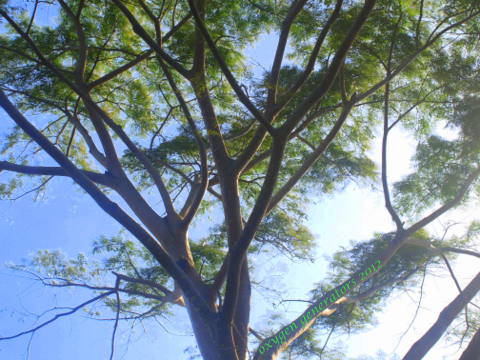Our tree is not common is our vicinity, it just grow there very luxuriantly and quickly as there are no other trees competing for sunlight. It easily outdid the height of the coconut trees around it. While in Bislig, I realized our tree can be sold to paper millers or furniture makers.
Birds love cavorting with one another inside its canopy. We see yellow orioles, coppersmith barbet, bulbuls, oriental magpie robin, brahminy kites, crows and other birds which i can't yet identify. That black something at the young branch is an oriole's nest. I once saw orioles and crows fight over something there inside the canopy, and they give very loud fighting sounds. I can only presume that the crows are trying to 'birdnap' the young 'oriolet' from the nest. Knowing how crows snatch my mother's chicks, I am sure they can also snatch the young orioles.
Above is how the canopy looks like during the start of the rainy season
It shed leaves during the dry season, March to May, and sprout leaves again when the rains come.
Without any big tree around it is standing proud and imposing in that area. It is a big haven for many creatures; birds, reptiles, insects. So, buyers' offer to cut that tree fell on deaf ears.
My nephew here was 7 years old, now he is 14. I cannot get a photo of the present trunk and buttress, as it is covered by profuse vines and bushes.It is clear here that no big size trees can be seen around it. Only some molave trees about 1 ft in diameter are present at the back.
This Big Haven for creatures is Albizia falcata, (syn Albizia falcataria, Molucca albizia). It is a tree legume that fixes atmospheric oxygen to use for its fast growth. So it tolerates poor soils.
Family: Mimosaceae
Distribution: It is native to the eastern islands of the Indonesian archipelago (Moluccas) and New Guinea, Southeast Asia like the Philippines, Burma, Malaysia, and Indonesia. It is now also introduced to tropical Africa and America. In the Philippines it is grown as a cash crop most especially in deforested areas, harvested after 7-8 years and another 8 years from the coppice.
Uses: It is one of the fastest growing timber trees, so its wood is light, used for making paper and substitute for pinewood as a pulping source. It is also used to make shelves, pallets, packing cases, match and tea boxes, and matches. It can also be used for making furniture.
Reference: For other detailed characteristics of growing, harvesting, economics, please click this reference.






What an amazing tree, and I can only imagine how much larger and wider the trunk has gotten in 7 years. It would be fun to see a picture of your nephew NOW in the same pose!
ReplyDeleteYou;re the first blogger I've seen mention the crucial role that trees play in oxygen generation!
Thanks Cathy and Steve for noticing about me as the first blogger to equate trees as oxygen generators, you are also the first one to say it loud!
DeleteHi Andrea, What a beautiful tree, and I loved seeing your cute little nephew. Thanks for visiting my blog and Don's woodland garden. His flowers/shrubs/trees are all perennial. They live through the sometimes difficult Iowa winters. Have a great week! Hope to see you for Fertilizer Friday and Bloomin' Tuesday!
ReplyDeleteThanks as well Beth, my nephew now will not like his photo posted as he is now a young teenager. I can just put it here because he doesn't normally check my blogsites. He gets annoyed when i post his photo in FB. Yes see you for Fertilizer Friday.
DeleteThat is a lovely tree.....it reminds me of my Jacaranda tree. I absolutely love the foliage on it and right now is in the process of leafing out with beautiful purple/lavender flowers. Incredible tree!!! I love your landscape so much...sometimes.....just sometimes.....I wish I could grow some of the plants you have there...here. That is one beautiful canopy to have around the home....and birds love it!!! Hope you are well.....love your take on this blog. It sounds like a fun fresh start. Kreesh:)
ReplyDeleteI always love the purple jacaranda i saw in Australia, but maybe they wont grow here well. It is also a legume. Thanks for loving our landscape "sometimes".
DeleteInteresting post and lovely photos, Andrea! That last photo with your nephew in it is a treasure.
ReplyDeleteI always love the purple jacaranda i saw in Australia, but maybe they wont grow here well. It is also a legume. Thanks for loving our landscape "sometimes".
Deletethe tree is amazingly beautiful but sad to see it's infested with termites.:( I hope they don't end up killing the tree. your nephew is very photogenic. :)
ReplyDeletehahaha, he is a young teenager now, but still goes with me to little adventures. Termites only eat dry wood not the living tissues, so the tree is fine.
DeleteHow nice to be able to go back to a place where such gigantic trees still stand tall. I would love to hug the tree.
ReplyDeleteI hugged it once, but now it is surrounded by shrubs and itchy vines! But it is really lovely if we have a reserve place we can still call our own and not allow development to conquer.
Delete